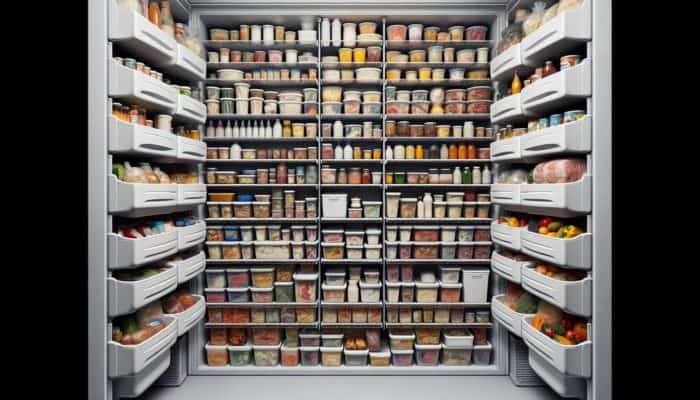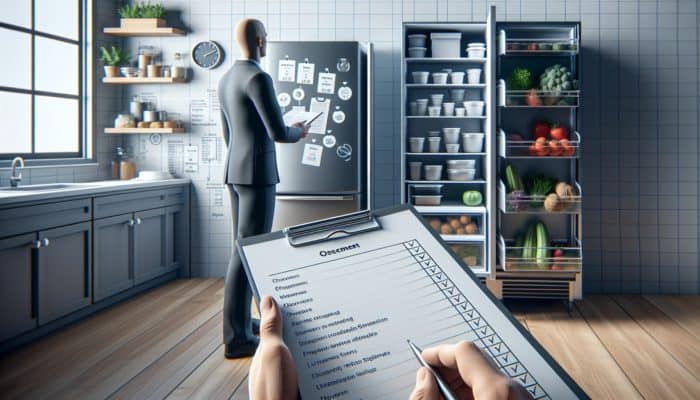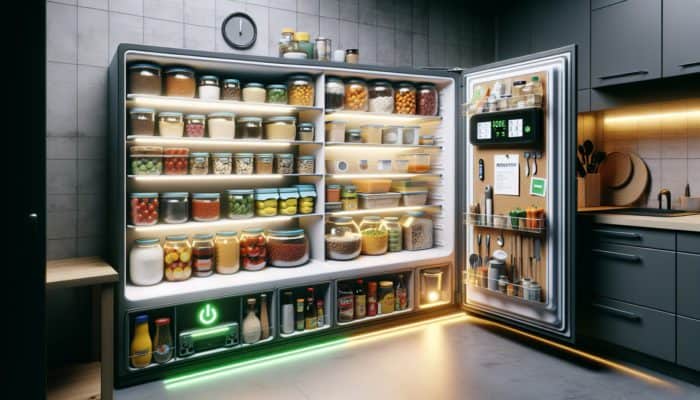Essential Steps for Preparing Your Freezer to Handle Emergencies
How to Efficiently Organise Your Freezer for Quick Access?

Top Freezer-To-Table Recipes For Emergencies: Efficiently organising your freezer is critical during emergencies, as it can significantly save you time and reduce food waste. When you can swiftly locate what you need, it alleviates stress amidst a crisis. Begin by grouping similar items, which not only aids in quickly finding ingredients but also helps manage your inventory effectively. Utilise clear, labelled containers or bags to easily identify contents, ensuring that everything is organised for effortless access.
Implementing a few practical organisational strategies can be immensely beneficial:
- Sort items by category: meats, vegetables, fruits, and prepared meals.
- Label bags and containers clearly with contents and freezing dates.
- Opt for clear containers that allow you to see the contents without needing to open them.
- Position older items at the front for easy access, ensuring they are utilised first.
- Use freezer bins or baskets to separate different food types effectively.
- Consider implementing a first-in, first-out (FIFO) method to rotate your stock efficiently.
- Attach a small, dry-erase board on the freezer door for an ongoing inventory list.
- Limit bulk purchases to what you can realistically consume to prevent spoilage and waste.
Strategically planning your freezer layout not only enhances accessibility but also promotes more efficient resource usage, ensuring that nothing goes to waste. This preparation is particularly crucial during emergencies when every second counts.
What Essential Items Should You Stock in Your Freezer for Emergencies?
To be well-prepared for any emergency, it is vital to stock your freezer with versatile ingredients. The aim is to select long-lasting foods that can be used in a variety of dishes, minimising the need for last-minute shopping trips. Foods that freeze well include meats, vegetables, and even certain grains, which can serve as the foundation for many meals.
Consider incorporating the following staples into your freezer:
- A variety of meat options, such as chicken, beef, and fish, can be utilised in numerous recipes.
- Frozen vegetables like peas, carrots, and mixed blends that pair well with any meal.
- Fruits such as berries and bananas are used in smoothies or desserts.
- Pre-cooked grains, such as rice or quinoa, are ideal for adding to various dishes quickly.
- Stock or broth to serve as a base for comforting soups and hearty stews.
- Prepared meals that can be quickly reheated during a crisis.
- Cheese and dairy products can enhance meals or be enjoyed as snacks.
- Bread and baked goods provide quick side options.
Having a diverse range of foods in your freezer empowers you to create balanced meals with minimal effort, ensuring that you can effectively respond to any emergency without compromising on nutrition or flavour.
What Are Effective Freezer Maintenance Tips?
Regular maintenance of your freezer ensures that your appliance operates efficiently, which is particularly crucial during emergencies when you depend on it to keep essential foods safe and secure. Maintaining the correct temperature—typically 0°F (-18°C) or below—is vital to prevent spoilage. Regular defrosting and cleaning are essential components of this upkeep.
To keep your freezer in optimal condition, consider these maintenance steps:
- Defrost your freezer regularly, especially if noticeable ice buildup occurs.
- Clean the interior using a mixture of Water and vinegar to eliminate odours effectively.
- Check the door seals for leaks, ensuring they close securely.
- Keep the freezer full but not overcrowded to maintain optimal air circulation.
- Monitor the freezer temperature using an appliance thermometer.
- Store food in airtight containers to prevent freezer burn.
- Schedule regular cleanings and inspections every few months to maintain efficiency.
- Keep the exterior clean, particularly the coils, to support efficient operation.
By following these maintenance tips, you’ll ensure that your freezer remains a dependable resource during emergencies, safeguarding the food you’ve diligently stocked up on.
How Often Should You Review Your Freezer Inventory?

Regularly reviewing your freezer inventory is crucial to ensure you are always prepared for any emergency. Conduct a monthly assessment to evaluate what you have on hand, ensuring you can quickly access meals or ingredients when needed. This practice not only keeps your stock fresh but also allows you to plan meals around items that need to be used soonest.
During your inventory checks, consider the following:
- Update your inventory list as items are used or added to keep it current.
- Check for any items that may be approaching their expiry date.
- Assess the quantity of staple items to ensure you’re sufficiently stocked.
- Identify any foods that need to be cooked or consumed within the next few days.
- Evaluate the necessity for restocking based on your meal planning.
- Take note of any items that are not being used regularly and adjust your shopping habits accordingly.
- Ensure that labelling remains clear and accurate for easy identification.
- Consider rotating or using items that have been in the freezer the longest.
Keeping a consistently updated inventory not only prepares you for emergencies but also promotes better food management practices, ultimately reducing waste and ensuring that you make the most of your resources.
Expert Insights on Top Freezer-to-Table Recipes for Emergency Situations
What Characteristics Make a Recipe Ideal for Emergencies?
An ideal emergency recipe is characterised by its rapid preparation, minimal ingredients, and nutritional value. When time is of the essence, you want recipes that can be executed quickly, especially those that can be cooked directly from frozen. Essential qualities include versatility, which allows for substitutions based on what you have on hand, and the ability to prepare meals in one pot or pan, thereby significantly reducing clean-up time.
Real-world examples of optimal emergency recipes include:
- Frozen Vegetable Stir-Fry: Quickly toss frozen vegetables in a hot pan with soy sauce and protein for a swift meal solution.
- Chilli: Use frozen beans, meat, and tomatoes to prepare a hearty dish that can simmer while you attend to other tasks.
- Soup: A base of frozen stock combined with various frozen vegetables and proteins can create a comforting and fulfilling meal.
- Pasta: Cook directly from frozen with sauce for a quick, filling dinner option.
- Casseroles: Layer frozen vegetables, meat, and grains; bake for a convenient one-pan meal.
- Breakfast Burritos: Fill tortillas with scrambled eggs, cheese, and frozen veggies, then freeze them for effortless breakfasts.
- Curries: Combine frozen vegetables and protein with coconut milk and spices for a warming dish.
- Frittatas: Incorporate frozen vegetables and leftover meats in a protein-packed dish.
Selecting recipes that meet these criteria simplifies navigating emergencies, allowing you to prepare nutritious meals without the stress of complicated cooking processes.
How Can You Adapt Recipes for Emergency Situations?

Adapting recipes for emergencies is crucial, especially when you may not have all the ingredients on hand. The ability to creatively substitute ingredients can significantly impact meal variety and nutrition during stressful times. Start by assessing what you have available in your freezer, pantry, and fridge to guide your substitutions.
Here are actionable steps for adapting recipes effectively:
- Identify the core components of a recipe, including protein, carbohydrates, and vegetables.
- Substitute similar ingredients based on what is available; for instance, use frozen spinach instead of fresh.
- Adjust cooking times for frozen ingredients; they may require longer to cook through.
- Utilise spices and condiments to enhance flavour, compensating for missing fresh ingredients.
- Change cooking methods; for example, roast instead of sauté if you have multiple items to cook at once.
- Consider portion adjustments; freezing leftovers can create quick meals later.
- Please keep it simple; focus on recipes that require minimal steps and ingredients.
- Experiment with textures; frozen fruits can be blended into smoothies or thawed for desserts.
This flexibility not only ensures that you can still create delicious meals but also reduces food waste, making the most of what you have available during an emergency.
Expert Tips for Mastering Freezer-to-Table Cooking
Experts suggest that successful freezer-to-table cooking relies on proper preparation and a solid understanding of cooking techniques. Maintaining a list of go-to recipes is invaluable, enabling you to act swiftly when emergencies arise. Familiarise yourself with methods that suit frozen ingredients to streamline the cooking process.
Key insights from cooking experts include:
- Regularly practice cooking your go-to recipes to build confidence in your skills.
- Experiment with cooking directly from frozen to eliminate thawing time and expedite meal prep.
- Utilise available kitchen gadgets, such as pressure cookers or slow cookers, for enhanced efficiency.
- Learn to layer flavours; even frozen ingredients can develop complexity with the right seasonings.
- Understand cooking times for various frozen items to avoid overcooking or undercooking.
- Keep essential cooking tools within easy reach to facilitate quick meal preparation.
- Incorporate meal planning into your routine, focusing on recipes that utilise freezer staples.
- Document successful adaptations and share them with others for collective learning and growth.
These expert tips provide a solid foundation for cooking efficiently from your freezer, ensuring you can create satisfying meals even in challenging situations.
Best Practices for Storing Freezer-to-Table Meals
Properly storing freezer-to-table meals is vital for preserving their quality and nutritional value. The method you use to package and label these meals can significantly influence their usability during emergencies. Understanding best practices will help you maintain the integrity of your meals for extended periods.
Consider these best practices for storing freezer meals:
- Utilise airtight containers or heavy-duty freezer bags to prevent freezer burn.
- Label each meal with its contents and date to effectively monitor freshness.
- Portion meals appropriately for individual servings to minimise waste.
- Leave space in containers for expansion during freezing to prevent bursting.
- Cool meals completely before freezing to maintain texture and avoid condensation.
- Avoid stacking hot meals on top of one another; allow them to freeze individually first.
- Organise items in the freezer by meal type for quick access during emergencies.
- Regularly check for any signs of spoilage or freezer burn and adjust accordingly.
By following these best practices, you can ensure that your freezer meals remain safe, nutritious, and ready for consumption at a moment's notice, providing peace of mind during emergencies.
Quick and Nutritious Freezer Meal Ideas
What Are Some Quick Freezer Meal Options?
Quick freezer meals are designed to minimise cooking time while still delivering nutritious, satisfying food. These meals should be easy to prepare and require minimal effort, especially during emergencies when time is of the essence. Understanding which meals freeze well can greatly simplify your cooking process.
Examples of quick freezer meals include:
- Frozen Vegetable Stir-Fry: A delightful mix of frozen vegetables tossed in a hot pan with your choice of protein makes for a quick meal.
- Pre-cooked Meats: Cooked chicken or beef strips are perfect for adding to salads or wraps for instant meals.
- Chilli or Stews: Cook in bulk and freeze in portions; they reheat quickly in a pot for a comforting meal.
- Pasta Dishes: Cook and freeze pasta with sauce for a quick and easy dinner solution. Reheat for a quick meal.
- Breakfast Burritos: Eggs, cheese, and veggies wrapped in tortillas provide a filling breakfast option that can be frozen.
- Quiches: Bake in advance and freeze; they can be reheated quickly for breakfast or lunch.
- Casseroles: Prepare and freeze casseroles for an easy, crowd-feeding option that warms up quickly.
- Soups: Blend and freeze various soups for quick, nutritious meals in case of emergencies.
These meals offer a variety of flavours and nutrients while allowing for quick preparation and minimal fuss when you need it most during an emergency.
How to Make Your Freezer Meals Nutritious?
Ensuring your freezer meals are nutritious involves a careful balance of proteins, vegetables, and grains. The foundation of a healthy meal is not just about convenience but also about meeting your dietary needs, particularly in times of stress. Incorporating a mix of food groups helps maintain energy levels and overall health.
To enhance the nutritional value of your freezer meals, consider the following strategies:
- Incorporate a variety of proteins, such as chicken, beans, or tofu, to meet your protein requirements.
- Add plenty of colours to vegetables; frozen options often retain their nutrients well during freezing.
- Utilise whole grains like brown rice or quinoa for added fibre and nutrients.
- Include healthy fats, such as olive oil or avocados, to support heart health.
- Opt for low-sodium or homemade broths in soups to control salt levels.
- Include herbs and spices for flavour without adding unnecessary calories.
- Plan for balanced meals that include a variety of food groups.
- Add frozen fruits to smoothies or desserts to boost your intake of essential vitamins and nutrients.
By thoughtfully constructing your freezer meals, you can ensure that they meet nutritional standards while remaining quick and convenient, making them perfect for emergencies.
Prepping Freezer Meals Ahead of Time
Prepping freezer meals in advance is a strategic way to save time and effort during emergencies. By preparing meals ahead of time, you ensure that nutritious options are readily available, reducing the temptation to resort to less healthy convenience foods when you're pressed for time.
Here are some effective meal prep tips that can help:
- Create a meal plan for the week or month, focusing on recipes that you enjoy and can prepare in bulk.
- Batch cook meals, making larger portions that can be divided and frozen for later use.
- Portion out meals into individual servings before freezing for easy access and quick meal solutions.
- Label everything clearly with names and dates to help track freshness and usage.
- Include a variety of meals to avoid monotony and keep mealtime exciting for your family.
- Utilise freezer-friendly containers for storage, ensuring they can withstand low temperatures without cracking.
- Involve family members in the prepping process to make it a fun activity that brings everyone together.
- Regularly review your freezer stock to adapt future meal prep based on what you have available.
Through strategic meal prep, you can develop a robust inventory of meals ready for emergencies, providing you with peace of mind and ensuring you maintain a nutritious diet, regardless of the situation.
Essential Cooking Techniques for Frozen Foods
What Are the Best Cooking Methods for Preparing Frozen Foods?
Cooking frozen foods efficiently requires knowledge of the best methods to preserve flavour and texture while ensuring safety. Each technique offers unique advantages, depending on the type of food being prepared. Selecting the right method is crucial for achieving tender, flavourful meals that meet your needs.
The best cooking methods for frozen foods include:
- Steaming: Ideal for vegetables, this method retains nutrients and texture while avoiding the addition of extra fat.
- Boiling: Quick and efficient, this method works well for pasta and grains, ensuring they heat evenly.
- Microwaving: The fastest option for reheating individual portions or cooking frozen meals without thawing.
- Oven Baking: Excellent for casseroles or baked goods, allowing for even cooking and a delightful crust.
- Stovetop Searing: Perfect for meats; searing from frozen can yield a better texture and flavour profile.
- Slow Cooking: Allows for tenderising tough cuts of meat, making it easy to create robust flavours over time.
- Grilling: Ideal for marinated frozen proteins, giving them a unique charred flavour.
- Pressure Cooking: Significantly reduces cooking time, making it perfect for soups and stews.
Understanding these cooking methods allows you to maximise the quality of your meals, ensuring that frozen foods are transformed into delicious, nutritious options during emergencies.
How to Thaw Frozen Foods Safely?
Thawing frozen foods safely is crucial to prevent bacterial growth and ensure food safety. The method you choose can impact both the texture and taste of the food, so it’s essential to follow best practices.
Safe methods for thawing frozen foods include:
- Refrigerator Thawing: This is the safest method for thawing food, as it allows the food to thaw gradually while maintaining a safe temperature.
- Cold Water Thawing: Submerge the food in cold Water, changing the Water every 30 minutes. This method is quicker but requires constant attention.
- Microwave Thawing: Use the defrost setting; however, ensure that you cook immediately after thawing, as some areas may start to cook.
- Direct Cooking: Foods like vegetables and certain proteins can be cooked directly from frozen, ideal for stir-fries or soups.
- Thawing in a Cold Oven: Place the food in a cold oven and set to a low temperature, allowing for gradual thawing before cooking.
- Thawing on the Counter: Not recommended, as this can lead to unsafe temperatures in the danger zone.
- Using Cooked Food: Use previously cooked foods, such as soups or stews, that were frozen after cooking.
- Thawing in the Fridge for Future Meals: Plan by transferring items from the freezer to the fridge the day before cooking.
By employing safe thawing techniques, you can maintain the quality and safety of your frozen foods, allowing for a greater variety of meal options.
Tips for Cooking Frozen Vegetables
Cooking frozen vegetables can be a straightforward process that preserves their nutrients and texture, making them an excellent addition to any meal. Using the right techniques will help achieve the best results and maximise their flavour.
Consider these tips for cooking frozen vegetables:
- Steam vegetables for a few minutes to preserve their vibrant colour and essential nutrients.
- Quickly sauté in a hot pan with a small amount of oil for a crisp texture.
- Add directly from the freezer into soups or stews for added nutrition without thawing.
- Blanch before freezing to help maintain colour, texture, and nutrients when cooking.
- Roast frozen vegetables with herbs and spices for enhanced flavour.
- Use them in stir-fries; the heat will cook them quickly while retaining their crunch.
- Include frozen vegetables in baked dishes, such as casseroles, as they will cook through in the oven.
- Always check the cooking times and methods on the packaging for optimal results.
These tips will ensure your frozen vegetables are cooked perfectly, providing a nutritious and tasty element to your emergency meals.
Research-Backed Benefits of Top Freezer-to-Table Recipes for Emergencies
What Nutritional Benefits Do Freezer Meals Offer?
Freezer meals can be incredibly nutritious when planned effectively. They often include a variety of essential food groups, providing a balanced diet even during emergencies. By incorporating whole foods, such as proteins, vegetables, and whole grains, you can maintain your health and well-being.
The nutritional benefits of freezer meals include:
- Convenience: Having meals prepared ahead of time makes it easier to maintain healthy eating habits.
- Preservation of Nutrients: Freezing can help lock in the vitamins and minerals present in fresh ingredients.
- Portion Control: Freezer meals can be pre-portioned, helping to manage serving sizes and reduce overeating.
- Diverse Offerings: Planning allows for a variety of meals, reducing monotony and ensuring a range of nutrients.
- Reduced Waste: Efficient meal planning helps minimise food waste, making the most of purchased ingredients.
- Accessibility: For those without immediate access to fresh foods, freezer meals provide a viable alternative.
- Time-efficient Preparation: Cooking in bulk saves time and ensures the availability of meals when needed most.
- Customisation: Meal prep allows for adjustments based on dietary needs or preferences, enhancing health benefits.
With careful planning and preparation, freezer meals can deliver exceptional nutritional benefits, ensuring you remain healthy and satisfied even during emergencies.
How Do Freezer Meals Help Save Time?
Freezer meals are a time-saving solution, especially in emergencies where cooking may become a secondary priority. These meals help streamline your cooking process, allowing for quick access to nutritious foods without the lengthy preparation or cooking times usually associated with meal prep.
Here are several ways freezer meals save time:
- Batch Cooking: Preparing large quantities at once reduces the number of cooking sessions required.
- Quick Reheating: Meals can often be reheated in a matter of minutes, providing immediate nourishment.
- Minimal Prep Time: Most freezer meals require little more than reheating, limiting the time spent in the kitchen.
- Ready-to-Cook Options: Meals can be cooked directly from the freezer, eliminating the need for thawing time. Up: Fewer cooking sessions mean fewer dishes to wash and less time spent cleaning.
- Streamlined Shopping: Planning and preparing meals in advance allows for bulk buying, saving time on shopping.
- Reduced Decision Fatigue: With meals prepped, there's no need to decide what to cook on a busy day.
- Consistent Meal Planning: Having a set stock of meals prepared facilitates ongoing meal planning.
By leveraging the time-saving advantages of freezer meals, you can ensure that nutritious options are available without sacrificing your time or energy during emergencies.
The Psychological Comfort of Prepared Meals
Having prepared meals in the freezer can provide substantial psychological comfort during emergencies. Knowing that you have meals ready to go can alleviate stress and anxiety, enabling you to focus on other pressing issues rather than worrying about food availability.
Key psychological benefits include:
- Reduced Stress: Having food prepared creates a sense of control during unpredictable situations.
- Increased Confidence: Knowing you have a nutritious meal at hand can boost your morale and sense of security.
- Enhanced Family Connection: Sharing prepared meals can strengthen family bonds, fostering a sense of community and togetherness.
- Time for Other Activities: With meals ready, you can devote time to other priorities or self-care.
- Predictability: Established meal routines can provide comfort and stability during chaotic times.
- Ease of Planning: Knowing what you have on hand reduces the mental load of meal planning.
- Support for Healthy Habits: Prepared meals lead to better eating choices, reducing reliance on takeout.
- Encouragement to Eat Well: Knowing a meal is readily available can promote better dietary practices, even in challenging times.
These psychological benefits underscore the importance of prepared meals, demonstrating that they are not just about nutrition but also about emotional well-being during challenging periods.
Versatile Freezer Ingredients for Emergencies
What Are the Most Versatile Freezer Ingredients to Keep on Hand?
Versatile freezer ingredients are the backbone of effective emergency meal planning. These ingredients can be used across a variety of dishes, offering flexibility and creativity in cooking, especially during times when fresh produce is not readily available.
Consider stocking your freezer with the following versatile ingredients:
- Meats: Chicken, beef, and pork can be used in a variety of recipes, from stir-fries to casseroles.
- Frozen Vegetables: A selection of mixed vegetables, including broccoli and peas, complements a wide range of dishes.
- Fruits: Berries, bananas, and mangoes can be added to smoothies or desserts.
- Grains: Cooked rice and quinoa can serve as the base for many meals, adding heartiness.
- Cheese: Shredded cheese can elevate dishes like casseroles, pizzas, and pastas.
- Broth or Stock: A versatile base for soups, stews, and sauces that adds flavour and nutrition.
- Bread: Various types of bread can be used for sandwiches or as a side for meals.
- Prepared Sauces: Having sauces like marinara or curry can simplify meal prep and enhance flavours.
By ensuring a well-rounded selection of these ingredients in your freezer, you can create a multitude of meals, making it easier to respond effectively to emergencies.
How to Use Frozen Proteins Effectively in Recipes?
Frozen proteins, such as chicken, beef, and fish, are essential components in many recipes, particularly during emergencies when quick meals are needed. These proteins can be used in a variety of dishes, offering flexibility and nutritional value in your meal planning.
Here’s how to effectively use frozen proteins in recipes:
- Add frozen chicken breasts directly to slow cookers with sauces for easy meal preparation.
- Incorporate frozen shrimp into stir-fries; they cook quickly without the need for thawing.
- Use frozen ground beef or turkey in sauces or casseroles while cooking from frozen.
- Thaw proteins in the refrigerator overnight for optimal safety and quality.
- Experiment with marinating proteins before freezing to enhance flavours.
- Include proteins in soups or stews for a hearty addition to meals.
- Consider using frozen fish fillets in baked dishes or pan-fried for a quick meal.
- Make meatballs or patties from frozen protein and cook them directly from frozen.
Using frozen proteins in these ways allows you to maintain nutritional balance while ensuring your meals are hearty and satisfying, making them perfect for emergency scenarios.
Storing and Using Frozen Fruits Effectively
Frozen fruits are a wonderful addition to your emergency meal plan, providing natural sweetness and essential vitamins. They can be used in smoothies, desserts, or as toppings, making them incredibly versatile while retaining their nutritional value.
To effectively store and use frozen fruits, consider the following tips:
- Keep fruits in airtight containers or freezer bags to prevent freezer burn.
- Label with the date to ensure freshness and track usage.
- Add frozen fruits to smoothies directly for a refreshing drink.
- Thaw fruits in the refrigerator or use them as-is in baked goods.
- Use frozen berries as toppings for oatmeal, pancakes, or yogurt.
- Incorporate into desserts like crumbles or pies for a comforting treat.
- Blend into sauces or syrups for drizzling over pancakes or waffles.
- Mix into salads for a sweet and tangy contrast.
By understanding how to store and use frozen fruits effectively, you can enhance your meals nutritionally while adding delightful flavours, making them perfect for emergency cooking.
Maximising the Use of Frozen Vegetables in Your Meals
Frozen vegetables are a staple for quick meals, especially during emergencies. They are not only convenient but also retain their nutritional content, making them an ideal choice for enhancing meals. Understanding how to maximise their usage is essential for efficient emergency meal planning.
To make the most of frozen vegetables, consider these strategies:
- Use them in stir-fries for a quick and colourful meal; add sauces for flavour.
- Incorporate into soups, adding them directly from frozen for ease of preparation.
- Make casseroles or bakes that include layers of frozen vegetables for added nutrition.
- Roast frozen vegetables with olive oil and seasonings for a delicious side dish.
- Mix frozen vegetables into omelettes or frittatas for a nutritious breakfast option.
- Utilise them in pasta dishes, combining with sauce for a hearty meal.
- Blend into smoothies for an unexpected nutrient boost.
- Consider adding them to sauces or curries for extra flavour and texture.
By employing these strategies, you can ensure that frozen vegetables become a reliable part of your emergency meal repertoire, providing quick, nutritious options without compromising on flavour.
Strategic Emergency Meal Planning with Freezer Foods
What Should Your Emergency Meal Plan Include?
An effective emergency meal plan should encompass a variety of meals that are quick to prepare and cater to different dietary needs. Planning ensures that you can respond swiftly during emergencies without the stress of last-minute cooking.
Key components to include in your emergency meal plan are:
- A variety of proteins, including those from chicken, beans, and fish, can meet diverse dietary needs.
- Diverse vegetables to ensure nutritional balance and prevent meal monotony.
- Whole grains, such as rice, quinoa, and pasta, provide energy and satiety.
- Healthy fats, including nuts and oils, are essential to maintain a balanced diet.
- Quick breakfast options, such as frozen fruits and oats, for easy mornings.
- Simple snack ideas, such as frozen yogurt or trail mix, are convenient between meals.
- Prepared meals that can be easily reheated for immediate nourishment without fuss.
- Consideration of dietary restrictions, ensuring inclusivity for all household members.
By proactively planning your emergency meals around these components, you can ensure that your family remains well-fed and nourished, regardless of the circumstances.
How to Effectively Rotate Your Freezer Stock?
Rotating your freezer stock is crucial to ensure that you use older items first, thereby preventing waste and maintaining the quality of your food. This practice also allows you to maintain an organised freezer, facilitating easier access to ingredients during emergencies.
To effectively rotate your freezer stock, implement these strategies:
- Label all items with dates to track freshness and usage effectively.
- Position newer items at the back and older items at the front for easy access.
- Regularly check expiration dates and plan meals around items that need to be used soon.
- Implement a first-in, first-out (FIFO) method to ensure that older items are used first.
- Keep a running inventory list to help track what needs to be consumed and prevent waste.
- Consider meal prepping with older items to utilise them efficiently and reduce waste.
- Encourage family members to be mindful of using older frozen foods in meal planning.
- Schedule regular freezer clean-outs to remove expired items and reassess your stock.
By establishing a systematic approach to rotating your freezer stock, you can optimise your resources, ensuring that nothing goes to waste while keeping your emergency meals accessible and nutritious.
Creating a Comprehensive Freezer Inventory
Maintaining an accurate inventory of your freezer contents is essential for effective meal planning. A well-kept inventory not only helps you know what you have on hand but also aids in meal preparation during emergencies, reducing the chances of last-minute confusion.
To create a functional freezer inventory, follow these steps:
- Take stock of everything in your freezer, noting quantities and expiration dates for easy reference.
- Organise items by category for easier reference (meats, vegetables, meals).
- Use a physical list or an app to keep track of inventory, ensuring you update it regularly.
- Include dates on your inventory to effectively monitor freshness and usage.
- Regularly review your inventory, updating it as items are used or added to keep it current.
- Consider using a magnetic board on the freezer for easy updates and visibility.
- Make meal plans based on available inventory to prevent waste and optimise usage.
- Encourage family involvement in tracking inventory to share the responsibility within the household.
An organised inventory will ensure that you’re always aware of what you have, enabling you to create balanced meals and maintain a functional and efficient emergency meal plan.
How to Safely Store Freezer Meals?
Safely storing freezer meals is vital to maintain their quality and safety. Understanding proper storage techniques will help prevent freezer burn and ensure that your meals remain appealing and nutritious when needed most.
Here are essential tips for safely storing freezer meals:
- Ensure meals are cooled completely before freezing to prevent condensation buildup.
- Use airtight containers or vacuum-sealed bags to effectively prevent air and moisture from entering.
- Label each meal with the contents and date for easy identification and tracking.
- Keep the freezer temperature at 0°F (-18°C) or lower for optimal preservation of food quality.
- Avoid overloading the freezer to maintain proper airflow and temperature consistency.
- Store meals in portion sizes to facilitate quick reheating without waste.
- Regularly check your frozen meals for signs of freezer burn or spoilage to address issues promptly.
- Rotate meals as you add new ones to ensure older meals are consumed first.
By following these storage tips, you can ensure that your freezer meals remain safe and enjoyable, providing you with nutritious options during emergencies.
Quick and Easy Freezer Meal Recipes to Consider
Preparing quick and easy freezer meal recipes in advance can significantly enhance your emergency preparedness. These meals can be quickly reheated, saving time and effort while ensuring you have nutritious options readily available.
Consider these simple yet delicious freezer meal recipes:
- Lasagna: Layer noodles with sauce, cheese, and vegetables; freeze before baking for a comforting meal that's ready in minutes.
- Chilli: Combine beans, ground meat, tomatoes, and spices; freeze in portions for easy reheating.
- Stir-Fry Kits: Pre-chop vegetables and protein, freeze with sauce; toss in the pan for a quick meal.
- Breakfast Burritos: Fill tortillas with eggs, cheese, and veggies; wrap and freeze for easy breakfasts.
- Soups: Cook and freeze various soups; reheat for a comforting meal option.
- Meatballs: Prepare and freeze meatballs in sauce for an easy meal over pasta or rice.
- Casseroles: Mix ingredients for a hearty casserole; freeze before baking for easy weeknight dinners.
- Quiches: Prepare and freeze quiches for a quick brunch or dinner option, packed with veggies and protein.
These recipes not only save time but also ensure you have nutritious meals available, making them perfect for your emergency meal planning efforts.
Frequently Asked Questions
How can I prepare my freezer for emergencies?
Organise your freezer by grouping similar items, labelling containers, and maintaining an inventory to ensure quick access during emergencies.
What are ideal foods to stock in my freezer?
Stock versatile ingredients, such as meats, frozen vegetables, fruits, and pre-cooked grains, to ensure you can prepare various meals quickly and efficiently.
How often should I check my freezer inventory?
Aim to review your freezer inventory monthly, updating it as items are used or added to maintain an organised stock and effective meal planning.
What cooking methods work best for thawing and cooking frozen foods?
Steaming, boiling, and microwaving are effective methods for cooking frozen foods, helping retain nutrients and flavour while ensuring safety.
Can I cook frozen proteins directly from the freezer without thawing them first?
Yes, many frozen proteins can be cooked directly, especially using methods such as slow cooking or stir-frying, without the need for thawing.
What are some quick freezer meal options?
Quick freezer meals include vegetable stir-fries, pre-cooked meats, and soups that can be reheated in minutes, providing immediate nourishment.
How can I ensure my freezer meals are nutritious?
Balance proteins, vegetables, and grains in your freezer meals, and consider adding healthy fats for optimal nutrition and health benefits.
What are the best practices for labelling freezer meals?
Label each meal with its contents and the date it was frozen to ensure you use older items first and maintain freshness throughout storage.
How can frozen vegetables be used effectively in meals?
Frozen vegetables can be used in stir-fries, soups, casseroles, or as side dishes, providing quick and nutritious options that are easy to prepare.
How can I maximise the use of my frozen foods?
Create a diverse inventory, utilise versatile ingredients in multiple recipes, and incorporate meal planning to make the most of your frozen foods, ensuring nothing goes to waste.



This post sheds light on an often-overlooked aspect of emergency preparedness that can truly make a difference in a stressful situation. Organizing a freezer not only streamlines meal preparation but also ensures that food stays fresh and minimizes waste—a concern that resonates with many of us, particularly in a world where sustainability is increasingly vital.
Your insights on freezer organization during emergencies resonate deeply, especially considering the unpredictable nature of recent events. The importance of having a well-maintained freezer cannot be overstated when it comes to stress reduction in crisis situations. However, while your suggestions about grouping similar items and labelling containers make practical sense, I wonder if they might also benefit from a more dynamic approach given our rapidly changing lifestyles and the variety of emergencies one might face.